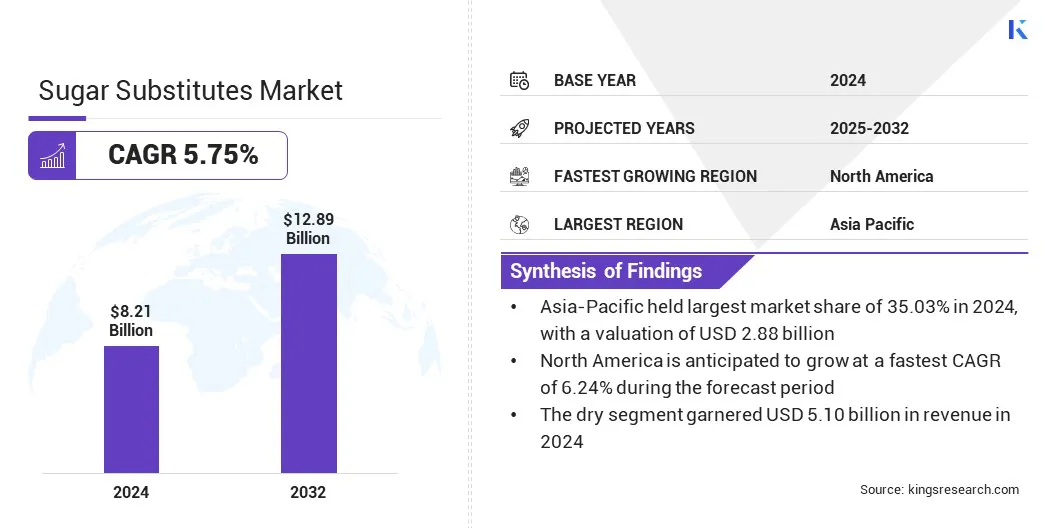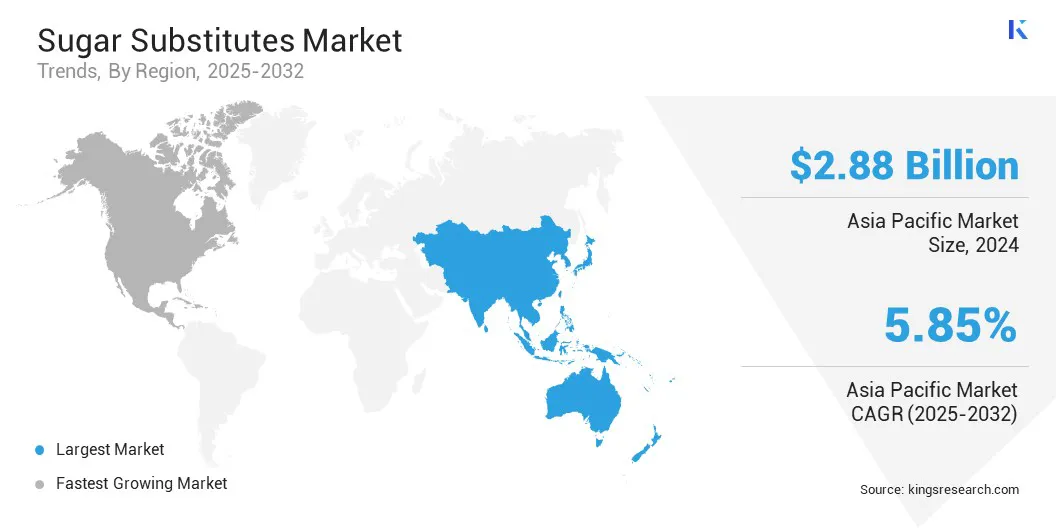Market Definition
Sugar substitutes are additives that replicate sugar's sweetness with reduced or no calorie content. They include artificial options such as aspartame and sucralose, and natural alternatives such as stevia and monk fruit extract.
These substitutes are increasingly used across food and beverage, pharmaceuticals, and personal care industries, fueled by increasing health awareness and dietary shifts. Demand is notably high among diabetic and calorie-conscious consumers aiming to manage blood sugar without compromising taste.
Sugar Substitutes Market Overview
The global sugar substitutes market size was valued at USD 8.21 billion in 2024 and is projected to grow from USD 8.66 billion in 2025 to USD 12.89 billion by 2032, exhibiting a CAGR of 5.75% during the forecast period.
This growth is attributed to the rising demand for low-calorie and sugar-free alternatives across key end-use sectors such as food and beverage, pharmaceuticals, and personal care. Increasing consumer focus on weight management, diabetes prevention, and overall wellness is boosting the adoption of sugar substitutes such as stevia, sucralose, and aspartame.
Key Highlights
- The sugar substitutes industry size was valued at USD 8.21 billion in 2024.
- The market is projected to grow at a CAGR of 5.75% from 2025 to 2032.
- Asia-Pacific held a share of 35.03% in 2024, valued at USD 2.88 billion.
- The high-intensity sweeteners segment garnered USD 3.32 billion in revenue in 2024.
- The dry segment is expected to reach USD 7.93 billion by 2032.
- The beverage segment is anticipated to witness the fastest CAGR of 6.05% over the forecast period
- North America is anticipated to grow at a CAGR of 6.24% through the projection period.
Major companies operating in the global sugar substitutes market are Cargill, Incorporated., ADM, Tate & Lyle, Ingredion, International Flavors & Fragrances Inc., Ajinomoto Co., Inc., Roquette Frères, DuPont, PureCircle, GLG Life Tech Corp, Celanese Corporation, JK Sucralose Inc., NutraSweetM Co, Kerry Group plc., and Whole Earth Brands.

The growing emphasis on healthy eating habits, reduced refined sugar intake, and supportive regulations are boosting market expansion. Additionally, advancements in formulation technologies, improved taste profiles of natural sweeteners, and strategic investments by leading food and ingredient manufacturers are accelerating this growth.
Market Driver
Rising Incidence of Lifestyle Diseases
The growth of the sugar substitutes market is propelled by the increasing incidence of lifestyle-related diseases such as diabetes, obesity, and cardiovascular conditions, largely fueled by poor dietary habits and high sugar consumption. As these chronic health issues continue to rise globally, consumers are actively seeking alternatives that allow for sugar reduction without compromising taste.
- According to the International Diabetes Federation, approximately 537 million adults had diabetes in 2021, a figure projected to rise to 853 million by 2050, underscoring the urgent need for healthier dietary options.
The growing focus on healthier dietary choices is fueling strong demand for low-calorie and non-nutritive sweeteners that aid in blood sugar control and weight management. Public health campaigns and clinical guidelines urging reduced sugar intake are prompting both consumers and manufacturers to seek effective alternatives.
This increased emphasis on preventive healthcare is accelerating the integration of sugar substitutes into a wide range of food and beverage products, making them a critical component of health-focused product strategies and a key factor driving market expansion.
Market Challenge
High Production Costs for Natural Alternatives
High production costs of natural sugar substitutes pose a significant challenge to the growth of the sugar substitutes market, particularly in price-sensitive developing regions. Extracting compounds from sources such as stevia leaves or monk fruit requires advanced processing technologies, specialized equipment, and strict quality control measures, increasing manufacturing expenses.
Additionally, limited raw material availability and supply chain inefficiencies increase costs, making natural sweeteners less accessible to mass-market food and beverage manufacturers.
To address this issue, companies are investing in cost-efficient extraction technologies, such as precision fermentation and enzymatic processing, which offer higher yields and scalability. Leading players are also adopting local sourcing strategies, vertical integration, and partnerships with agricultural producers to improve supply stability and lower input costs across production stages.
Market Trend
Widespread Adoption of Natural and Plant-Based Ingredients
The widespread adoption of natural and plant-based ingredients is significantly influencing the sugar substitutes market by aligning with growing consumer demand for clean-label, health-conscious products.
Plant-derived sweeteners such as stevia, monk fruit, and coconut sugar are gaining preference due to their natural origin, lower glycemic impact, and favorable health perceptions compared to artificial alternatives. These ingredients support dietary goals related to diabetes management, weight control, and overall wellness without compromising sweetness or flavor.
Ongoing advancements in extraction and formulation technologies are enhancing the taste, stability, and scalability of plant-based sweeteners, making them increasingly viable for a wide range of food, beverage, and nutraceutical applications.
Furthermore, the integration of natural sweeteners into reformulated and new product launches is helping brands meet regulatory guidelines and consumer expectations for transparency and sustainability.
- In February 2023, A study by the University of Surrey found that stevia-based sweeteners generate up to 90% fewer greenhouse gas emissions than sugar while delivering similar sweetness. The research highlights stevia’s environmental and health advantages, including reduced land and water use, supporting its utilization in sustainable food production.
Sugar Substitutes Market Report Snapshot
|
Segmentation
|
Details
|
|
By Type
|
High-intensity Sweeteners (Natural, Artificial), Low-intensity Sweeteners (Xylitol, Sorbitol, Maltitol, Mannitol, Trehalose, Isomaltulose, Others), and High-fructose Corn Syrup
|
|
By Form
|
Dry, and Liquid
|
|
By Application
|
Food (Bakery, Confectionery, Diary, Others), Beverage (Juices, Functional Drinks, Carbonated Drinks, Alcoholic & Non-alcoholic, Plant-based Drinks, Others), Pharmaceuticals, and Personal Care
|
|
By Region
|
North America: U.S., Canada, Mexico
|
|
Europe: France, UK, Spain, Germany, Italy, Russia, Rest of Europe
|
|
Asia-Pacific: China, Japan, India, Australia, ASEAN, South Korea, Rest of Asia-Pacific
|
|
Middle East & Africa: Turkey, U.A.E., Saudi Arabia, South Africa, Rest of Middle East & Africa
|
|
South America: Brazil, Argentina, Rest of South America
|
Market Segmentation
- By Type (High-intensity Sweeteners, Low-intensity Sweeteners, and High-fructose Corn Syrup) : The high-intensity sweeteners segment earned USD 3.32 billion in 2024, primarily due to rising demand for low-calorie, high-sweetness ingredients in food and beverage applications.
- By Form (Dry and Liquid): The dry segment held a share of 62.15% in 2024, attributed to its longer shelf life, ease of handling, and wide applicability in packaged and processed food products.
- By Application (Food (Bakery, Confectionery, Diary, Others), Beverage (Juices, Functional Drinks, Carbonated Drinks, Alcoholic & Non-alcoholic, Plant-based Drinks, Others), Pharmaceuticals, and Personal Care): The food segment is projected to reach USD 4.24 billion by 2032, owing to increasing demand for sugar-reduced and calorie-controlled formulations across bakery, confectionery, and dairy products.
Sugar Substitutes Market Regional Analysis
Based on region, the market has been classified into North America, Europe, Asia Pacific, Middle East & Africa, and South America.

Asia Pacific sugar substitutes industry share stood at 35.03% in 2024, valued at USD 2.88 billion. This dominance is reinforced by the region’s high prevalence of diabetes and obesity, growing health awareness, and increasing consumer preference for low-calorie and sugar-free alternatives in everyday diets.
Rising disposable incomes, rapid urbanization, and widespread adoption of functional and clean-label food products are further supporting the uptake of sugar substitutes across the region.
Furthermore, strong government support for sugar reduction policies, expanding food manufacturing capabilities, and the presence of both regional and global players contribute to a robust and competitive market environment. The region’s continued investment in natural sweetener innovation, improved distribution infrastructure, and rising demand for preventive healthcare solutions are fostering regional market expansion.
- In November 2023, Ingredion expanded its PureCircle stevia facility in Malaysia, increasing bioconversion capacity fourfold to support growing global demand for high-purity steviol glycosides such as rebaudioside M and D. The upgrade enhances production scale and taste performance in sugar-reduced food and beverage formulations, offering manufacturers versatile, clean-label sweetening solutions.
The North America sugar substitutes market is set to grow at a CAGR of 6.24% over the forecast period. This growth is propelled by increasing health consciousness, a high prevalence of obesity and diabetes, and strong consumer demand for sugar-free and low-calorie food and beverage products.
The region’s early adoption of clean-label trends, widespread availability of functional foods, and growing popularity of ketogenic and low-carb diets are accelerating the integration of sugar substitutes in mainstream consumption.
Government support for sugar reduction initiatives, favorable regulatory approvals for emerging sweeteners such as allulose, and strong investment in food innovation are further contributing to regional market growth. Moreover, the presence of leading food and beverage manufacturers, advanced R&D capabilities, and a well-established retail infrastructure fosters regional market expansion.
- In March 2024, U.S.-based received the FDA’s “No Questions” letter for brazzein, a sweet protein developed through precision fermentation. This enables its use as a high-intensity, clean-label sugar alternative in a variety of food and beverage applications.
Regulatory Frameworks
- In the U.S., the Food and Drug Administration (FDA) regulates sugar substitutes under the Federal Food, Drug, and Cosmetic Act. It evaluates both artificial and natural sweeteners for safety through the Generally Recognized As Safe (GRAS) process or food additive petitions, ensuring approved substances meet safety and labeling standards for use in food and beverages.
- In the EU, the European Food Safety Authority (EFSA) governs the approval and use of sugar substitutes under Regulation (EC) No 1333/2008 on food additives. It mandates rigorous scientific risk assessments, maximum usage levels, and specific labeling requirements to ensure consumer safety and uniformity across member states.
- In Japan, the Ministry of Health, Labour and Welfare (MHLW) regulates sugar substitutes through the Food Sanitation Act. It oversees the approval process for both synthetic and natural sweeteners, requiring safety data and compliance with usage limits in specified food categories.
- In India, the Food Safety and Standards Authority of India (FSSAI) regulates sugar substitutes under the Food Safety and Standards (Food Products Standards and Food Additives) Regulations, 2011. It defines approved artificial and natural sweeteners, usage limits, and mandatory labeling requirements to ensure product safety and consumer transparency.
Competitive Landscape
Companies operating in the sugar substitutes industry are actively enhancing their market presence by focusing on natural ingredient innovation, expanding product portfolios, and entering new markets. They are investing heavily in research and development to improve the taste, texture, and stability of sugar alternatives, with a strong emphasis on clean-label, plant-based, and low-calorie formulations.
They are also adopting advanced production technologies such as enzymatic processing and fermentation to increase efficiency and reduce costs associated with natural sweeteners. Additionally, firms are engaging in strategic collaborations with food manufacturers, expanding their presence in health-conscious consumer segments, and strengthening supply chains to ensure consistent quality and global scalability.
- In January 2024, Avansya, a joint venture between Cargill and dsm-firmenich, received positive safety opinions from the European Food Safety Authority (EFSA) and the United Kingdom Food Standards Agency (FSA) for its EverSweet stevia sweetener. Made via fermentation to produce high-purity rebaudioside M and rebaudioside D, EverSweet supports sugar reduction with a sugar-like taste and significantly lower environmental impact.
List of Key Companies in Sugar Substitutes Market:
- Cargill, Incorporated.
- ADM
- Tate & Lyle
- Ingredion
- International Flavors & Fragrances Inc.
- Ajinomoto Co., Inc.
- Roquette Frères
- DuPont
- PureCircle
- GLG Life Tech Corp
- Celanese Corporation
- JK Sucralose Inc.
- NutraSweetM Co
- Kerry Group plc.
- Whole Earth Brands
Recent Developments (Product Launch)
- In July 2024, Tate & Lyle introduced Optimizer Stevia 8.10, a new stevia composition designed to deliver a sugar-like taste at high replacement levels while reducing cost-in-use by up to 15% compared to other premium sweeteners. The formulation uses underutilized steviol glycosides and qualifies for clean-label “stevia extract” claims, offering versatility across applications such as beverages, gummies, nutrition bars, and yogurt.


